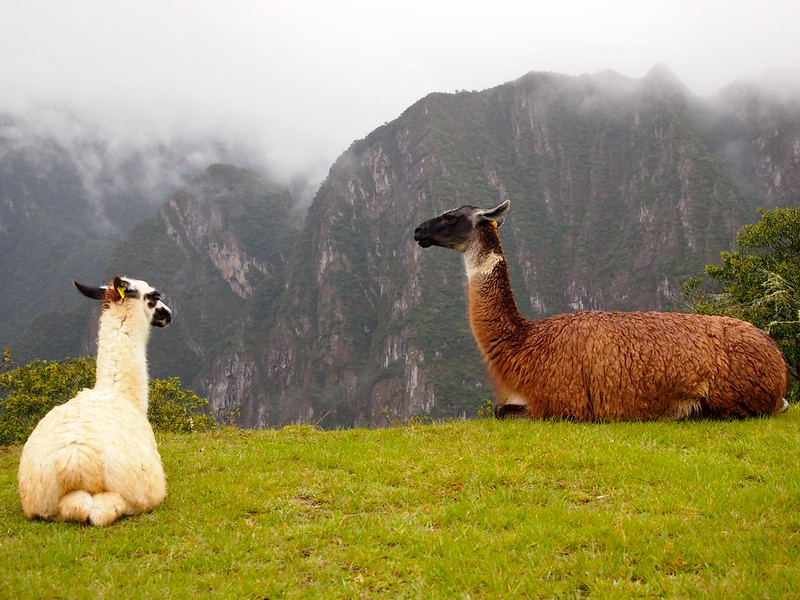Machu Picchu: a whopper for our 100th post!
We got 99 posts but Machu Picchu ain’t one. Until now! Thanks to everyone who is still following along. We really enjoy keeping this blog and hope you enjoy reading it, wherever you are.
November 19, 2013:
“There it is!” Carlos, our guide to the Inca Trail exclaimed. “Dead Woman’s Pass! It’s right there!” He pointed to an impossibly far away saddle between two craggy peaks — at 4,200m/13,780 ft it’s at roughly the same altitude as the summit of Mount Rainier and marks the highest point on the Inca Trail. We were taking a rest in a high alpine meadow before the final uphill push — we had just hiked uphill for three straight hours, many people around us were gasping for breath at the nearly 4,000-meter altitude, and a porter was about to keel over from illness and exhaustion. I thought longingly of the luxurious train and wondered what I’d gotten myself into.
Several weeks earlier:
Jordan and I had just read a great book called A Million Miles in a Thousand Years, where author Donald Miller talks about a great many things, telling stories from his life. One of those stories happened to be about the time he hiked the Inca Trail to Machu Picchu. In order to psych himself out and start exercising in preparation for the trail, he would Google “Inca Trail excruciating” and read harrowing tales of hardship on the four-day trek. This, to me, seemed counterproductive. Having never done any major multi-day trek in my life, I was already nervous enough. Instead, I Googled “Inca Trail old lady” and got back tons of confidence-boosting “if she can do it, surely so can I” stories. As someone who had never previously hiked for more than one day, never slept in a tent until I was nearly 30, and would never be described as “outdoorsy,” the thought of tackling a trail described as “rugged” at best and “excruciating” at worst was nerve-wracking.
But I’m here to tell you, the Inca Trail is challenging but do-able, and dare I say it, even fun.
Part of what made this trip so memorable is that my sister came out from Seattle to do the trek with us. Becca, I think you’re half-mad to spend a precious week of vacation time hiking and camping in the woods, but I’m glad you did.
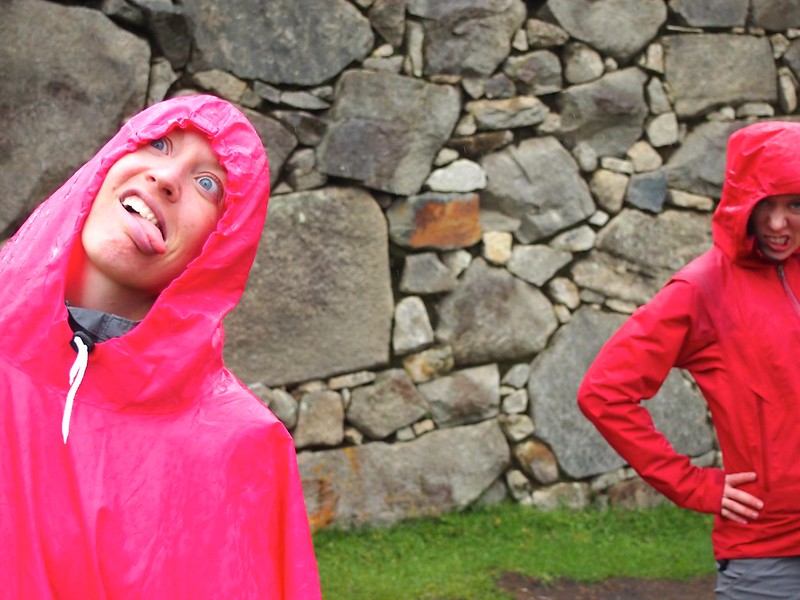
If you decide to make the trek and brave the Andes for three days, I highly recommend doing so with Peru Treks, the company we went with. Knowledgable guides, sturdy equipment, and great food! Seriously, the food was amazingly good and plentiful. We had soup to start every lunch and dinner, a huge variety of food at every meal, fresh meats and veggies. On the last night, there was even a cake! How did they do that?
No write up of the Inca trail would be complete without mentioning the absolutely incredible porters. We had 20 porters for 16 hikers. These little wiry guys would wake us up in the morning with a hot tea, make us breakfast and then break down camp as we started hiking. Then they would race past us in their t-shirts and sandals, shouldering 50-pound packs, in order to set up and cook lunch. They do the same after lunch and then clap for us when we make it into camp. With the porters working so hard, all you have to do is walk. While these men are amazing, tales of companies mistreating their porters is rampant. We recommend going with a company that takes porter welfare seriously and makes sure the porters adhere to the official weight limits, have their own food and a dry, warm place to sleep.
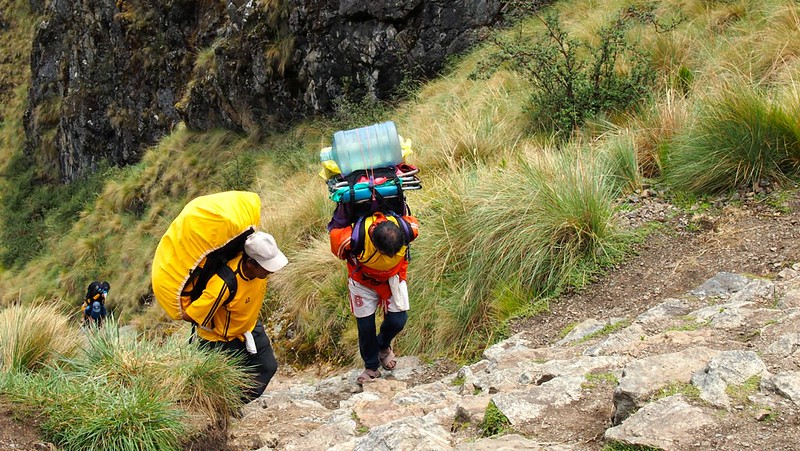
On to the trail!
Nov. 18 — Day 1 — Ollantaytambo to Wayllabamba
Distance: 12 kms/7.5 miles
Altitude gain: 400 m/1,300 ft
Altitude loss: 0 m
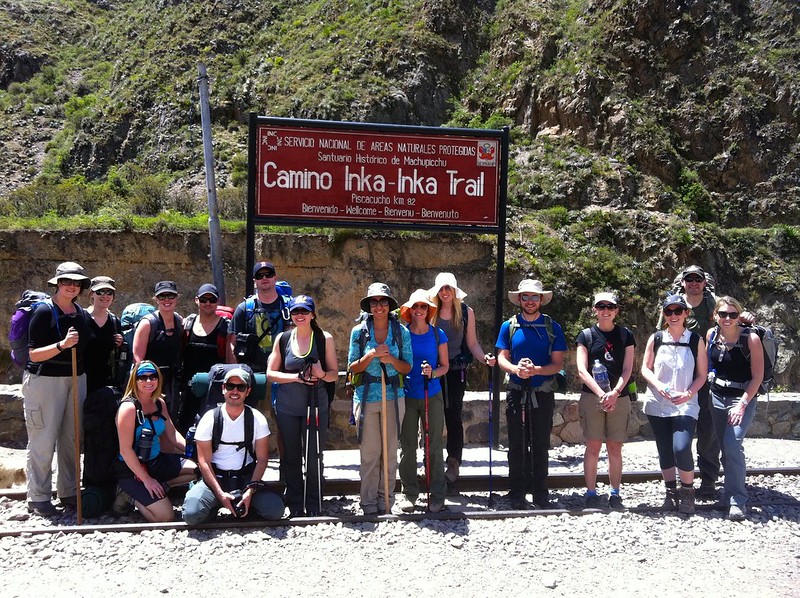
Anyone who hikes the Inca trail starts the experience with a few days in Cusco, the ancient capital of the Incas. Since Cusco sits at 3,310m/10,860 ft, roughly the same height as the summit of Mount Hood, Becca flew in a few days early to acclimatize, which basically consists of resting and drinking coca tea. There are loads of museums and churches to visit in Cusco, but doing most anything requires buying the pricey boleto turistico, a ticket that covers some — but not all — of the sites. We found this out when we hiked up to the Saksaywaman (inevitably pronounced “sexy woman”) ruins on a hill above Cusco, only to be turned away for lack of a ticket. We thought the ticket was a bit of a shakedown and skipped it, instead opting to hike over to the (free) Christo Blanco statue. As Jordan quipped, “Saksaywaman is expensive, but Jesus is free for everybody.”
When the big day finally arrived, we started early with a twisty, stomach churning ride from Cusco to Ollantaytambo, the old Inca town in the Sacred Valley that is the jumping-off point for the Inca Trail. Poor Becca, who’d woken up that morning not feeling well, only got greener with every mile.
We queued up to get our ticket stamped and gain official entrance to the Trail. The porters were on a ridge below us, having their packs weighed to ensure they were in compliance with official weight restrictions. That’s one thing about the Inca Trail: it is regulated. It is legit. You need a permit and everything. You can’t just show up with your boots and your sleeping bag and get in. Due to the trail’s popularity, the Peruvian government has decided to control the crowds / get a piece of the action and only gives out 500 permits per day and requires hikers to go with a company. Permits sell out fast — when we booked in the summer, the earliest available date was for mid-November.
We got stamped in, crossed a bridge over the Urubamba River, and we were off! The first day, truly, is easy. Mostly flat, lots of breaks, only about 12 kilometers along the river. We also had great weather, despite it being the rainy season. What a good omen, we thought!
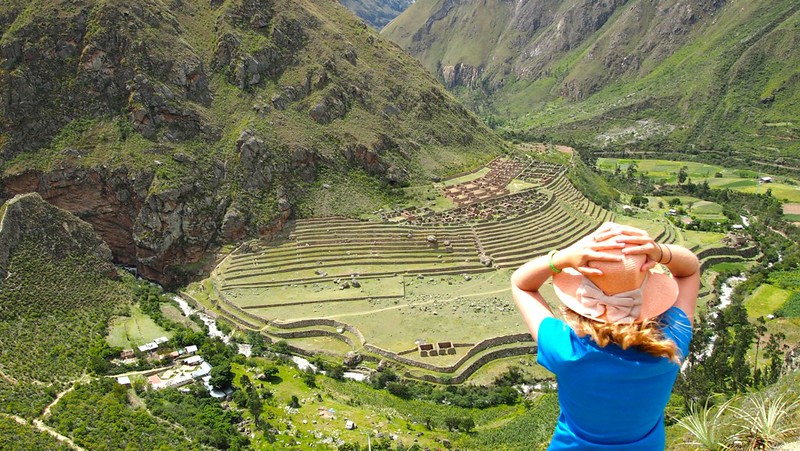
Nov. 19 — Day 2 — Wayllabamba to Pacamayo
Distance: 12 kms/7.5 miles
Altitude gain: 1,200 m/3,940 ft
Altitude loss: 600 m/1,970 ft
The ominous, scary Day 2. Hell Day. This is the day that allegedly broke marathon runners and left people reeling for oxygen in the thin air. (OK, so maybe I did read some of those horror-story trip reports, too).
It’s a five hour, 1,200 meter climb up to “Dead Woman’s Pass” and then another two hours of joint-crunching downhill work from there. And Becca, from the way she was poking at her breakfast, wasn’t feeling any better. She wasn’t alone. About half of our group suffered from one illness or another. One American girl was holding a big bottle of electrolytes as we were lining up on Day 1, already ill before she took the first step. She didn’t make it more than 10 or 15 minutes. A strapping Canadian couple, regular hikers carrying big packs, got decimated by the altitude. And one poor Australian girl got some sort of parasite or bug that made her vomit all night before the morning we went to Machu Picchu. She made the entire Inca Trail, and then went straight to a hotel in Aguas Calientes, the little town down the mountain from the ruins.
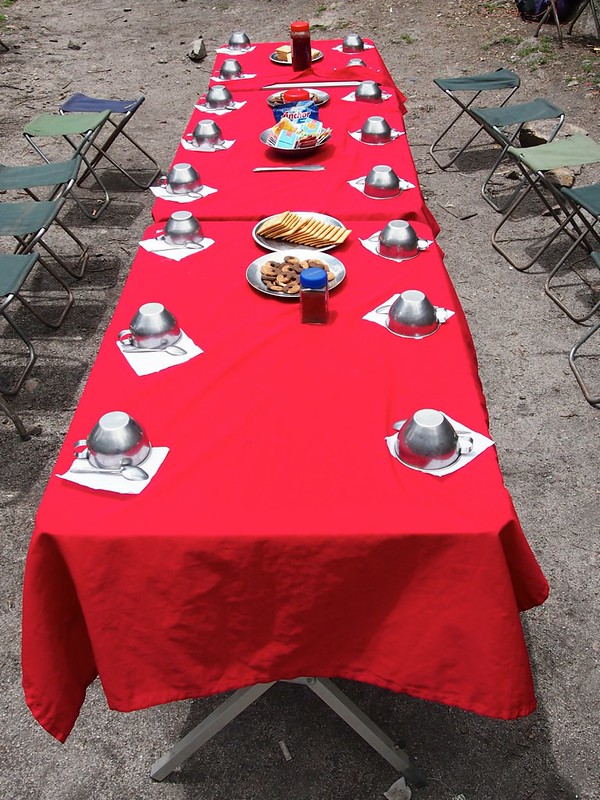
And Day 2 is hard work. Up, and up, and up, the air getting thinner, rain starting to pelt us, plagued one minute by fierce winds and the next by scorching sunlight. I was peeling off and adding layers constantly. Becca was flagging. But she is as stubborn as they come, and pragmatic, too. She knew the only way off that mountain was to keep putting one foot in front of the other. I am proud to say we still finished at a decent time. I rewarded myself with a dark chocolate Milky Way. Becca rewarded herself with a lie-down. Here’s the worst part about Day 2, in my opinion — the walk back down. Everyone hypes up the big mountain pass, but then it’s several more hours down steep stone steps from there. About half way down, I ran out of gas. Every step was an effort, and all I wanted to do was crawl into my tent, take off my shoes, and sleep for 10 hours. Eventually, Becca and I made it into camp. Hallelujah.
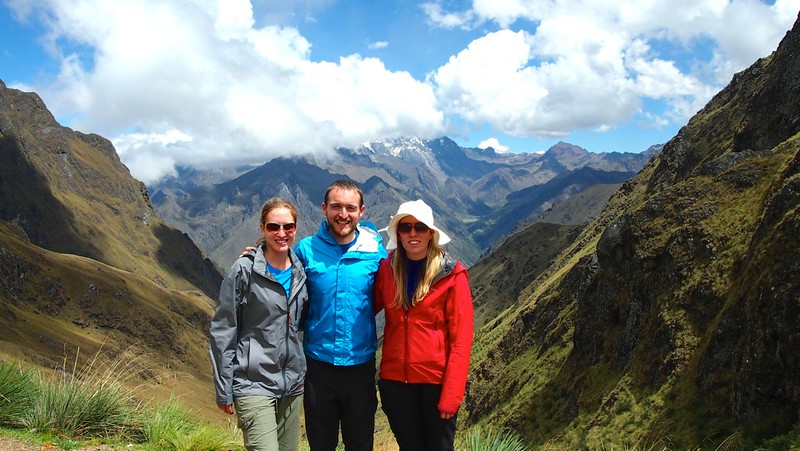
(I) showed my respect for the Pachamama by lying down in the dirt and embracing her with every traumatized cell in my body.
Mark Adams, Turn Right at Machu Picchu
Where was Jordan all this time, you’re asking. Jordan had discovered the power of coca leaves. (Yes, this is the plant that they make cocaine out of, but only one of coca’s 16 alkaloids is used in cocaine and you have to do a whole lot of nasty stuff to the leaves, like pour in kerosene, to make cocaine). Coca leaves were and are the lifeblood for people living in the Andes. Just for starters, they are used as currency, as offerings to spirits, as medicine, and as a mild stimulant to ease back-breaking work. Our guide, Carlos, showed Jordan how to properly chew coca leaves. First, you must pick your three best leaves and blow them in the direction of three mountains, to appease the apus, or mountain gods. Then, being very careful not to spill any of the coca leaves on the ground (“That will really offend the porters,” he warned), you stack up a wad of leaves, shave some llipta (quinoa ash) on top, roll it up, and stick it between your gum and the inside of your cheek, like chewing tobacco. I told Jordan he looked like he was about to go gun slinging at the OK Corral with that stuff in his mouth. He claims it gave him nothing more than a distraction from the hiking and a numb mouth, but he made such great time up the mountain our group teased him that he rode an all-terrain Segway up. Coca or CrossFit? The world may never know.
Nov. 20 — Day 3 — Pacamayo to Wiñay Wayna
Distance: 15 kms/9.3 miles
Altitude gain: 200m/656 ft
Altitude loss: 900m/2,953 ft
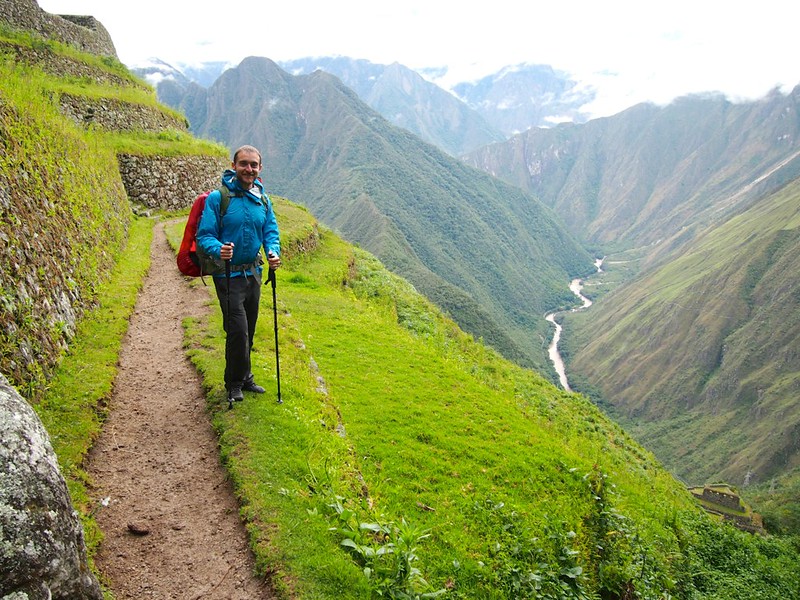
Despite this being the longest day (up at 5:30, into camp just before dark) and accompanied by several hours of drizzle, this was the best day of hiking. Ninety percent of it is on the original stone trail laid by the Incas 500 years ago. You pass multiple Inca ruins — lookouts, fortresses, and administrative stops on the road to Machu Picchu — and wind your way through a lush cloud forest covered in orchids.
We stopped for lunch amidst a constant drizzle, on top of a ridge that would surely offer magnificent views in better weather. I felt so sorry for our porters, who must have surely hustled to ensure we had the prime lunch spot, all for nothing. Lunch, however, was spectacular. It was time for our cook to show off his Peruvian cooking. We had a mushroom ceviche starter, followed by quinoa soup, and then stuffed spicy peppers, a sort of spaghetti casserole with eggs and olives, vegetables, cheesy potatoes, rice, more dishes than I can even remember. And rice pudding for dessert. I wanted a nap, not to hike another 7 or 8 kilometers.
Stuffed from that incredible lunch, we started on the next part of the trail: hundreds and hundreds of steep stone steps that wound precariously down the side of the mountain, made slick and treacherous by the rain. Thank goodness we rented trekking poles! They saved our knees from taking the impact of hundreds of steps. And best of all, Becca was feeling better, shouting back useful tidbits learned from her outdoorsy Seattle friends like “Trust your boots” and “Put more weight on the poles,” and “Don’t step there, that rock is loose and you will fall off the mountain.”
The last portion of the day presents a choice: the long way or the shortcut. Jordan took the long way past some beautiful terraces and ruins. We took the shortcut and Becca made friends with a deer! Win.
Nov. 21 — Day 4 — Wiñay Wayna to Machu Picchu
Distance: 5 kms/3.1 miles
Altitude gain: 0m
Altitude loss: 300m/984 ft
This was it — the day we’d worked so hard for. The day we got to lay eyes on Machu Picchu, the Inca’s lost city in the clouds. We were up at 3:30 to get a spot in the queue that opened at 5:30. We were one of the first groups in line, and then we were off on the last 5 kms of the trail. On our sore legs and blistered feet, we didn’t walk to the Sun Gate: we ran. Pachamama blessed us with swift and sure feet as we flew the last five kilometers to get that coveted glance of Machu Picchu from the Sun Gate, the fortress built into the last pass on the trail. It was near vertical work at times and we arrived, sweaty and spent, after three days of hiking to … nothing. Clouds thick as cotton had entirely obscured the view from the Sun Gate. During the rainy season, that’s apparently the case 70 percent of the time, so I was stupid to be disappointed, but I was stupid and disappointed.
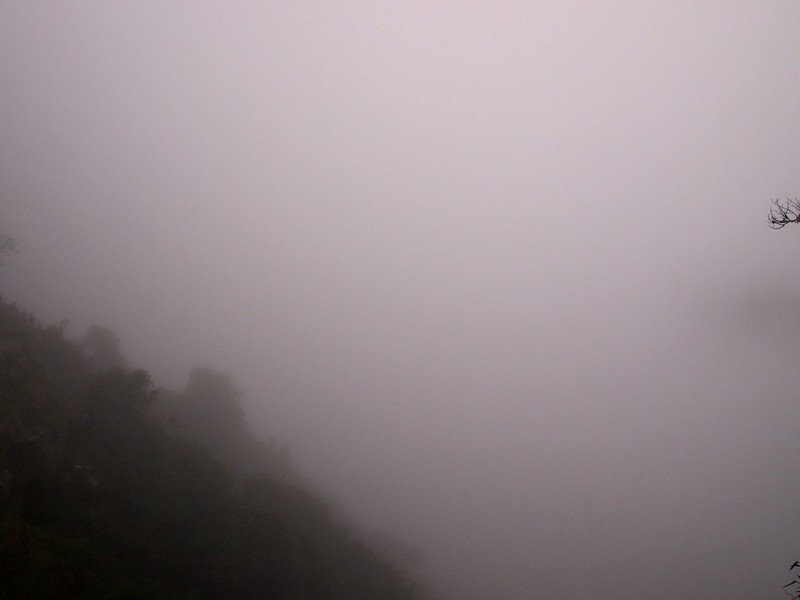
We walked for another half hour or so toward the ruins when suddenly the clouds parted and we got our first glimpse of what we’d come so far to see. And you know what? It was absolutely worth it. Machu Picchu was breathtaking, incredible in its size, its location, its engineering, and in its abiding mystery. You’ve seen the pictures a hundred times, but nothing beats the real thing.
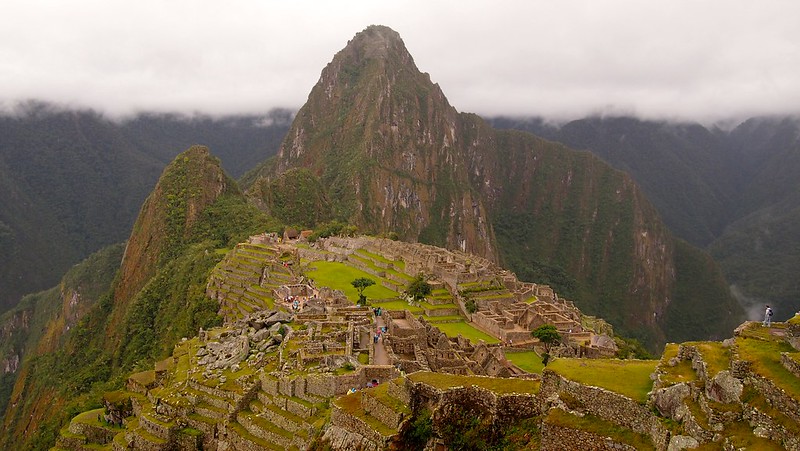
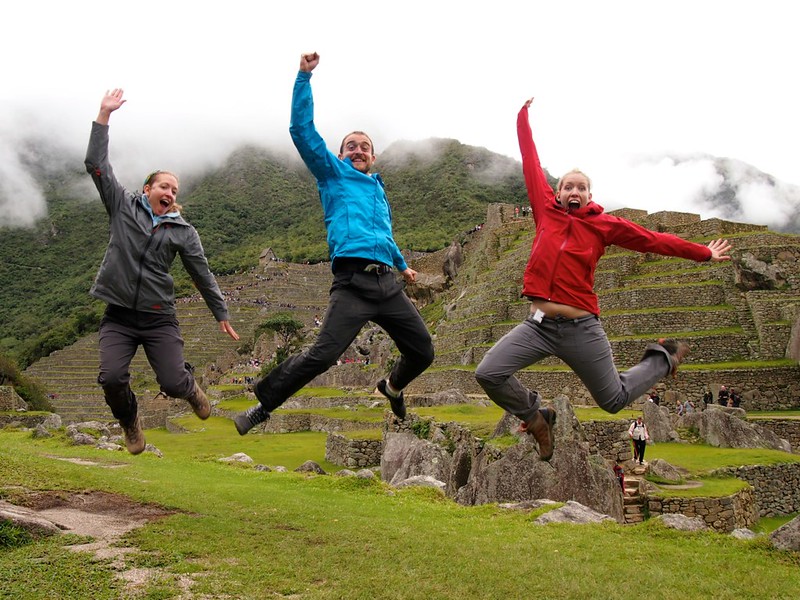
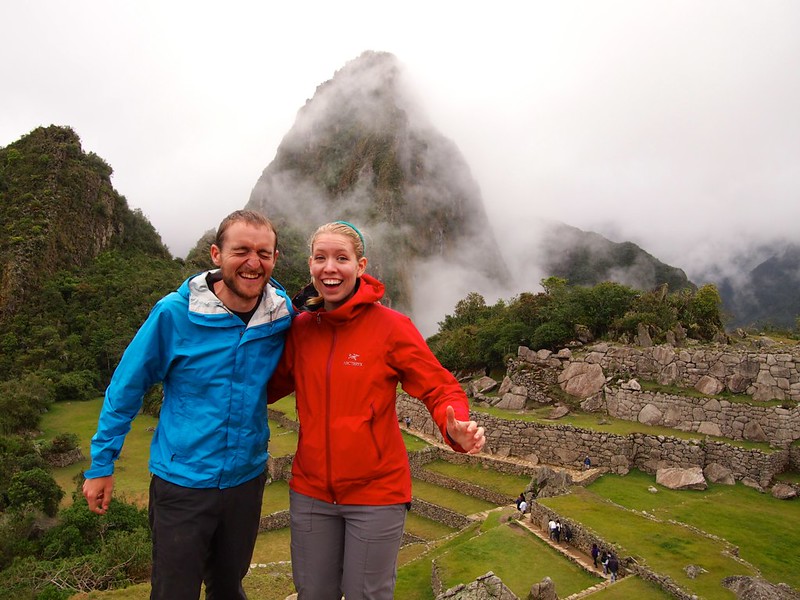
For the first time since dropping out of graduate school, I remembered an unpleasant weekend spent struggling to comprehend the philosopher Immanual Kant’s explanation of the difference between calling something beautiful and calling it sublime. Nowadays, we throw around the word ‘sublime’ to describe gooey desserts or overpriced handbags. In Kant’s epistemology, it meant something limitless, an aesthetically pleasing entity so huge that it made the perceiver’s head hurt. Machu Picchu isn’t just beautiful, it’s sublime.
— Mark Adams, Turn Right at Machu Picchu
In an ironic twist, the best part about Machu Picchu ended up being what I had dreaded — the hard work required to get there.
The pain made the city more beautiful. The story made us different characters than we would have been if we had skipped the story and showed up at the ending in an easier way. It made me think about the hard lives so many people have had, the sacrifices they’ve endured, and how those people will see heaven differently from those of us who have had easier lives.
— Donald Miller, A Million Miles in a Thousand Years
I’m sure that people who ride the train and bus there also find it thrilling and beautiful. But for me, my exhaustion, sweaty clothes, sore knees, and tender feet only made the place more special. I felt that I had earned it, that I had proved to myself that I was equal to this kind of a challenge. And because I knew that we had gotten to Machu Picchu the old fashioned way — we walked there.

